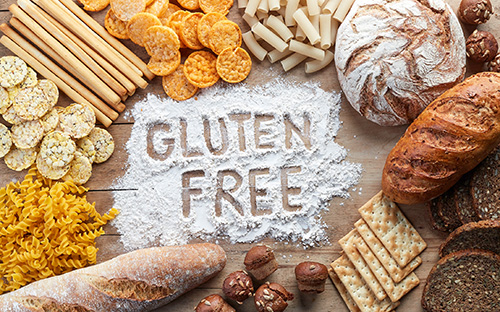Authored by Dr. Amber Hayden, DO
Lately going gluten-free is all the rage. Basic foods are boasting “gluten-free” labels in the grocery store, gluten-free bakeries are popping up in many cities, pizzerias are perfecting gluten-free crusts, and neurologist Dr. David Perlmutter’s book Grain Brain was on international bestseller lists for months! What’s going on?

You may have heard that gluten is related to a serious condition known as Celiac disease. But researchers are now figuring an additional 18 million out there are simply sensitive to gluten, which means you might experience any of the following symptoms.
Symptoms of gluten sensitivity
- Digestive trouble
- Fatigue
- Foggy thinking (“brain fog”)
- Joint and muscle pain
- Headaches
- Skin rashes
- Numbness and tingling in hands and feet
These symptoms may go on for years without you making the connection to gluten. And over time, gluten can negatively affect your joints, brain, heart, bones and especially your thyroid. Dr. Perlmutter writes about gluten, carbs and sugar playing a role in dementia, ADHD, chronic headaches, anxiety and more.
You may be surprised to learn that going gluten-free is right for you.
5 steps to gluten-free
You may have thought about eliminating gluten, but worried it would be next to impossible in your busy life. Here’s an easy step-by-step approach to removing gluten:
1. Make a gluten-inventory list.
How much gluten do you really eat? If breakfast is a bagel, a bowl of cereal, a frozen waffle or toast, write these down on a “gluten-inventory list”. Do the same for lunch and dinner. At the end of three days you should have a pretty good idea of how much gluten you eat on a daily basis and how much change you’re dealing with. At this point you can assess whether eliminating gluten cold turkey is best for you (we recommend this if you are experiencing miserable symptoms) or if a gradual reduction will be best.
TIP: Start taking a quality probiotic to support healthy digestion.
2. Start with one gluten-free meal a day.
If you’ve opted for a gradual elimination, try cutting gluten out of one meal per day for one week. This most likely won’t solve any major symptoms related to gluten-sensitivity, but it’s a nice chance to dip your toe into the pool of how life without gluten feels.
Easy gluten-free meal ideas
Breakfast:
Eggs and fruit; gluten-free oatmeal with walnuts and apples; plain yogurt topped with fruit; sausage (turkey or pork) with rice and veggies
Lunch:
Leftovers from dinner (soup, stew, stir fry, etc.); chicken, salmon or other protein choice over lettuce greens; organic turkey (or other lunch meat) in a gluten-free wrap with lettuce and tomato. (Be sure to warm your wrap and add some oil/butter to the pan to help its elasticity. You can do this the night before and briefly warm it before eating.)
Dinner:
Salmon (or other favorite fish), beef, chicken, shrimp over rice with wilted garlic greens; roasted chicken with root vegetables; fish tacos on corn tortillas; beef or turkey chili over rice; rice and beans with avocado,

Dinner is often the easiest place to start, especially if you are a meat and potatoes kind of girl. Go for fish, grass-fed beef, organic chicken or even beans and rice. Stir fry some vegetables or make a salad for fiber and try rice, potatoes or quinoa as your carbohydrate. After the first week, try eating two gluten-free meals a day, and then three in the third week.
TIP: Instead of pasta or bread, roast sweet and white potato chunks together with olive oil and sea salt, steam rice with cilantro, lime and sea salt, or simply make a fruit salad as carb side dishes.
3. Stock up on gluten-free snacks.
As you remove gluten from your daily life, your body may feel hungrier than usual as it adjusts. Keep some healthy snacks nearby, being sure to include high-quality protein and fat in each. And don’t worry, this intense hunger won’t last forever. Your body simply needs to adjust to being satisfied without gluten.
TIP: Some gluten-free snacks include tortilla/lentil chips with guacamole, gluten-free trail mix, cheese and fruit, vegetables and hummus, or mixed nuts and raisins.
4. Allow for restorative time as your body detoxifies.
Though gluten is not exactly considered an “addictive substance”, it does take some time to clear out of your body. And especially if you decide to remove gluten cold-turkey, you may feel tired or experience headaches and joint pain. This too will pass. Be kind to yourself for a week or two while your body rebalances.
TIP: Drink plenty of water, plan for naps or downtime each day and go to bed earlier than usual.
5. Don’t think of going gluten-free as a “diet.”
If it works for you, going gluten-free is a way of life. And if you don’t try to substitute every gluten-filled food you once loved (there are lots of unhealthy gluten-free processed foods out there!), you end up eating mostly whole, fresh foods that taste delicious and make you feel fantastic. The minute you feel trapped by your gluten-free life, negativity can swoop in and ruin meals and special occasions. If friends are overwhelmed by your new choice and complain that they can’t have you for dinner or don’t know where to go to eat out with you, keep a positive attitude. These days, most restaurants have gluten-free options on the menu (even if they don’t list them as “gluten-free”) and you can always call ahead to be sure.
TIP: Once you’ve mastered a few scrumptious gluten-free recipes, have friends for dinner or offer to bring a dish to someone else’s house. We have some delicious gluten-free options in our Digestive Reset Protocol.
Your pathway to more energy, clear thinking and healthy digestion
For some women, gluten (as well as diary, sugar and/or other food groups) can act as a toxin in the body, resulting in symptoms of fatigue, poor digestion, brain fog and more. If you are experiencing digestive distress, fatigue or other food sensitivity-related symptoms and you’re not sure it’s gluten, we have an at-home approach to eliminating the most common food offenders and gradually introducing them back to discover which food is bothering you. Our Digestive Reset Protocol includes: a quality probiotic, L-glutamine (to repair the gut lining), a two-week elimination diet, delicious recipes and phone support from our Wellness Coaches. You’re going to love how you feel after this opportunity to reset your digestion!
For a more information, see our article Gluten-intolerance and celiac disease.
Center for Celiac Research. 2011. University of Maryland School of Medicine researchers identify key pathogenic differences between celiac disease and gluten sensitivity. URL: https://somvweb.som.umaryland.edu/absolutenm/templates/?a=1474.
Vojdani, A, et al. 2008. The immunology of gluten sensitivity beyond the intestinal tract. European Journal of Inflammation, 6(2). URL: https://www.thedr.com/images/immunologyofgs-2.pdf.
Perlmutter, D. 2010. Gluten sensitivity and the impact on the brain. Huffpost Health. URL: https://www.huffpost.com/entry/gluten-impacts-the-brain_b_785901
Perlmutter, D. 2014. Personal Website. URL: https://www.drperlmutter.com/about/grain-brain-by-david-perlmutter/.










